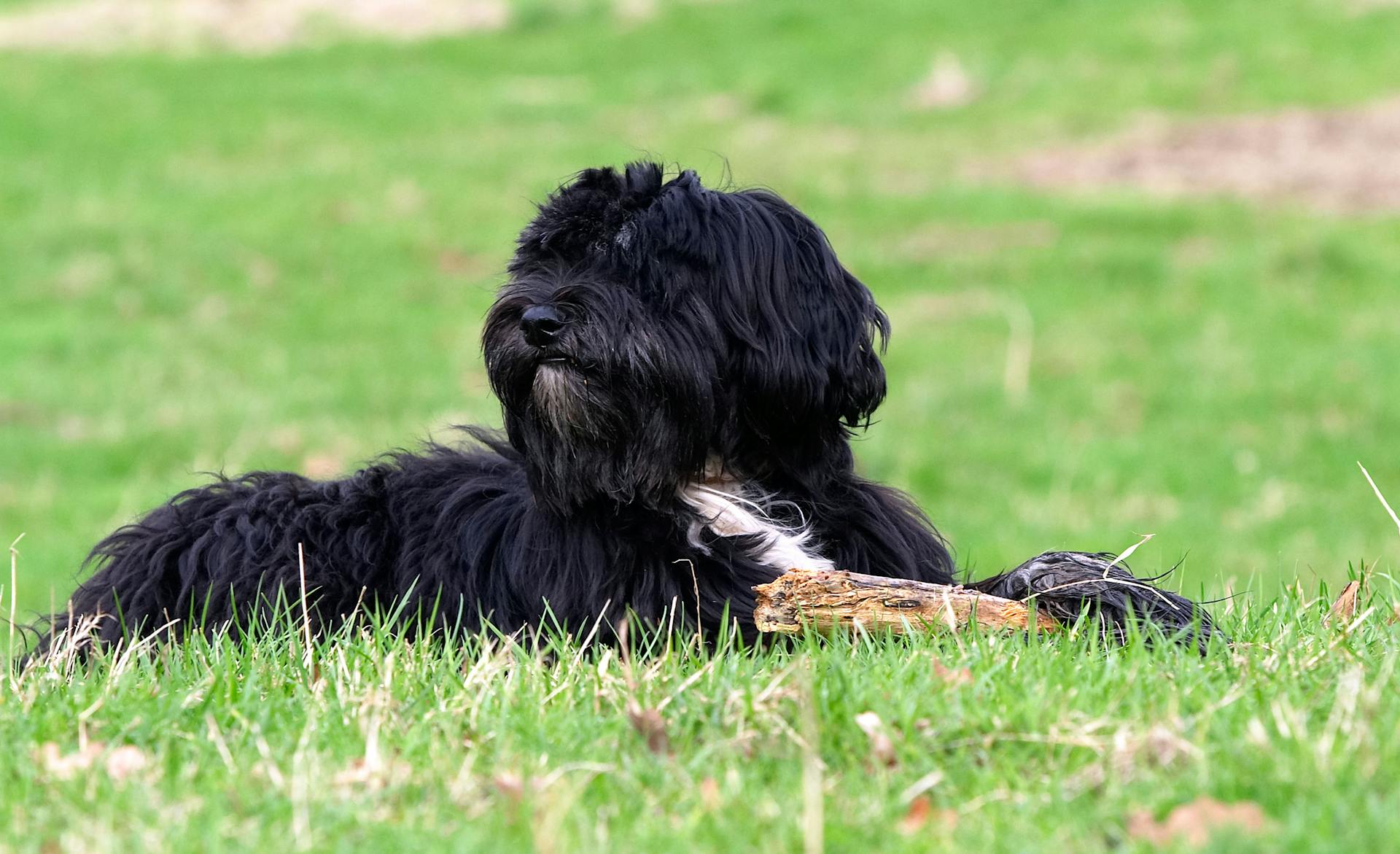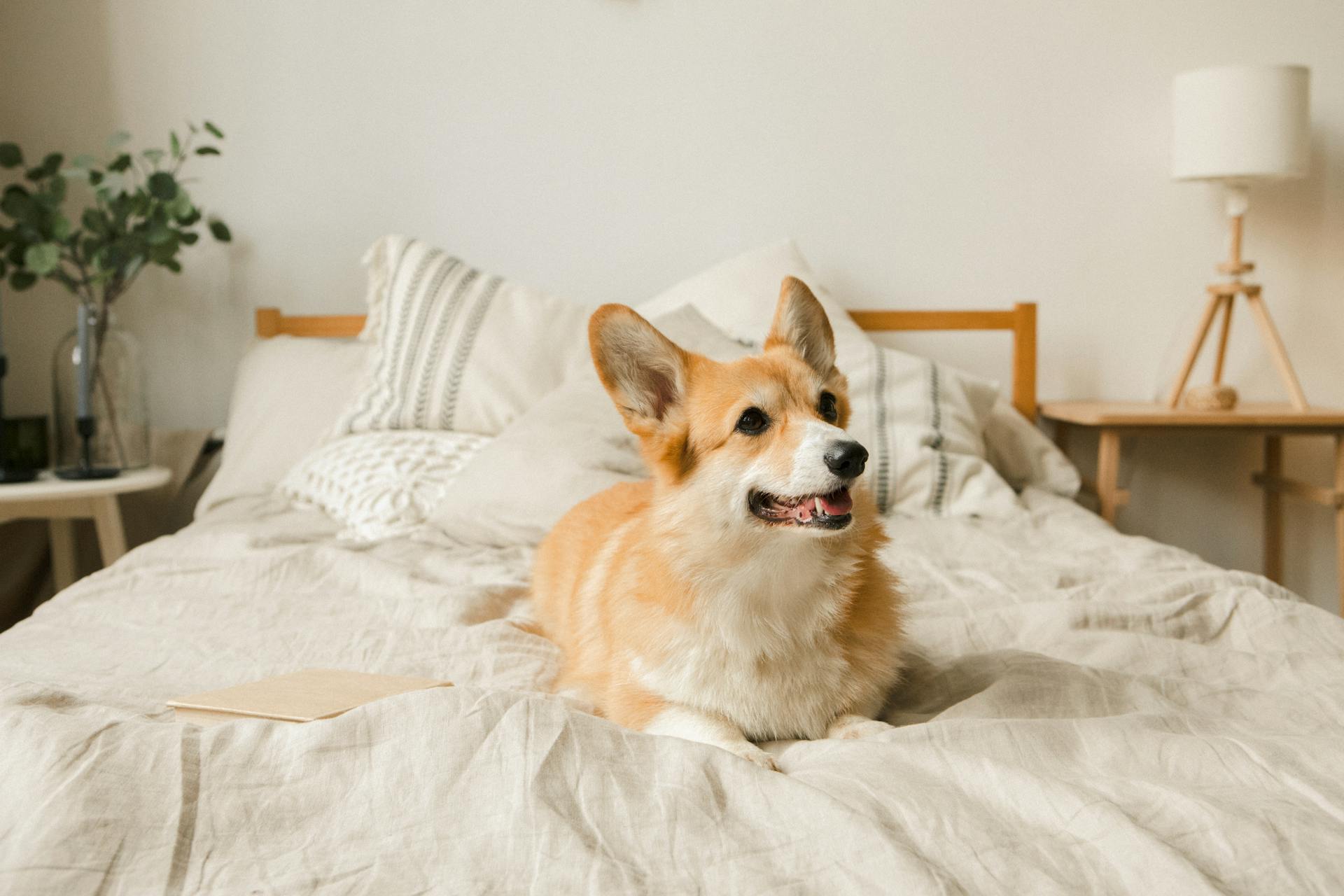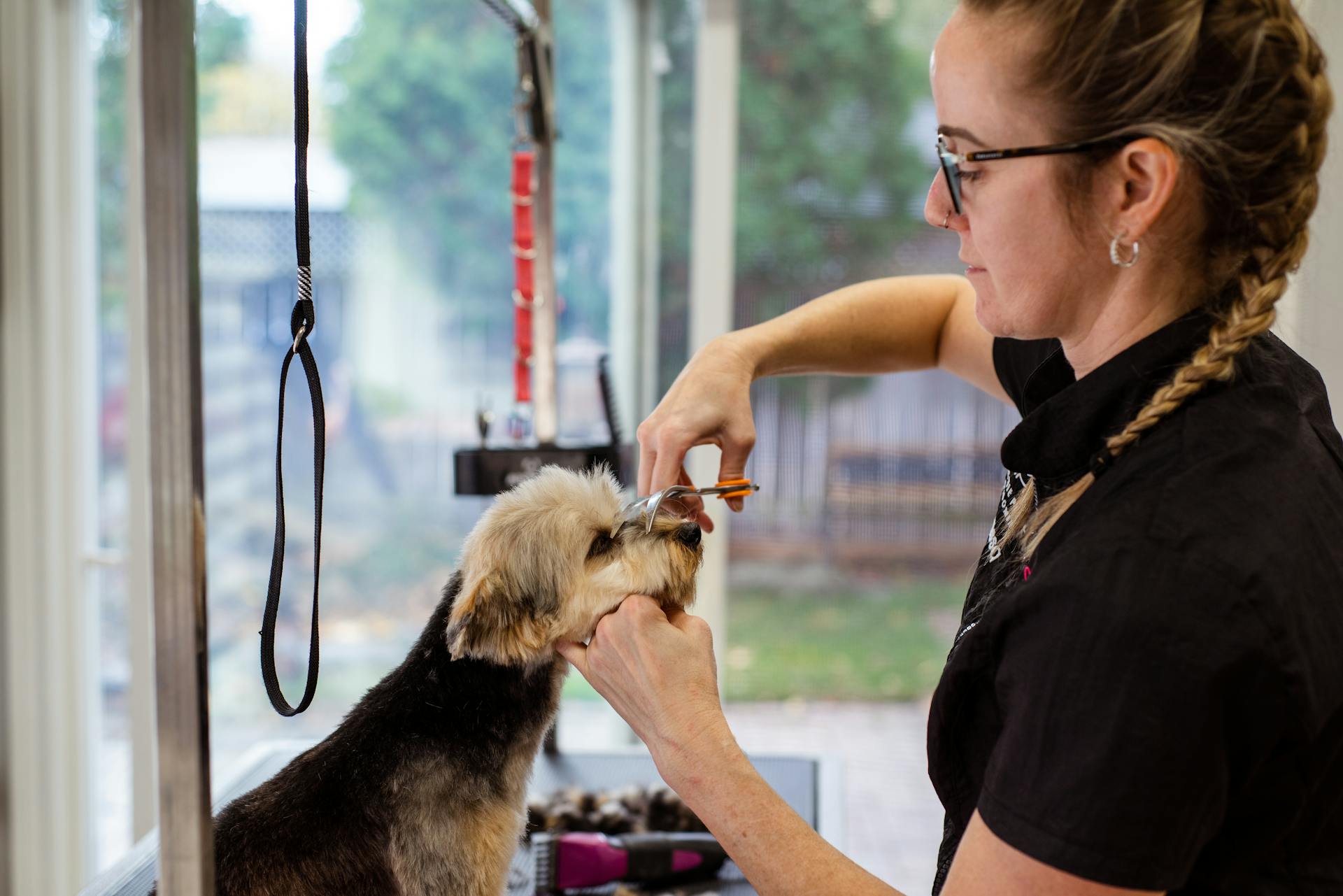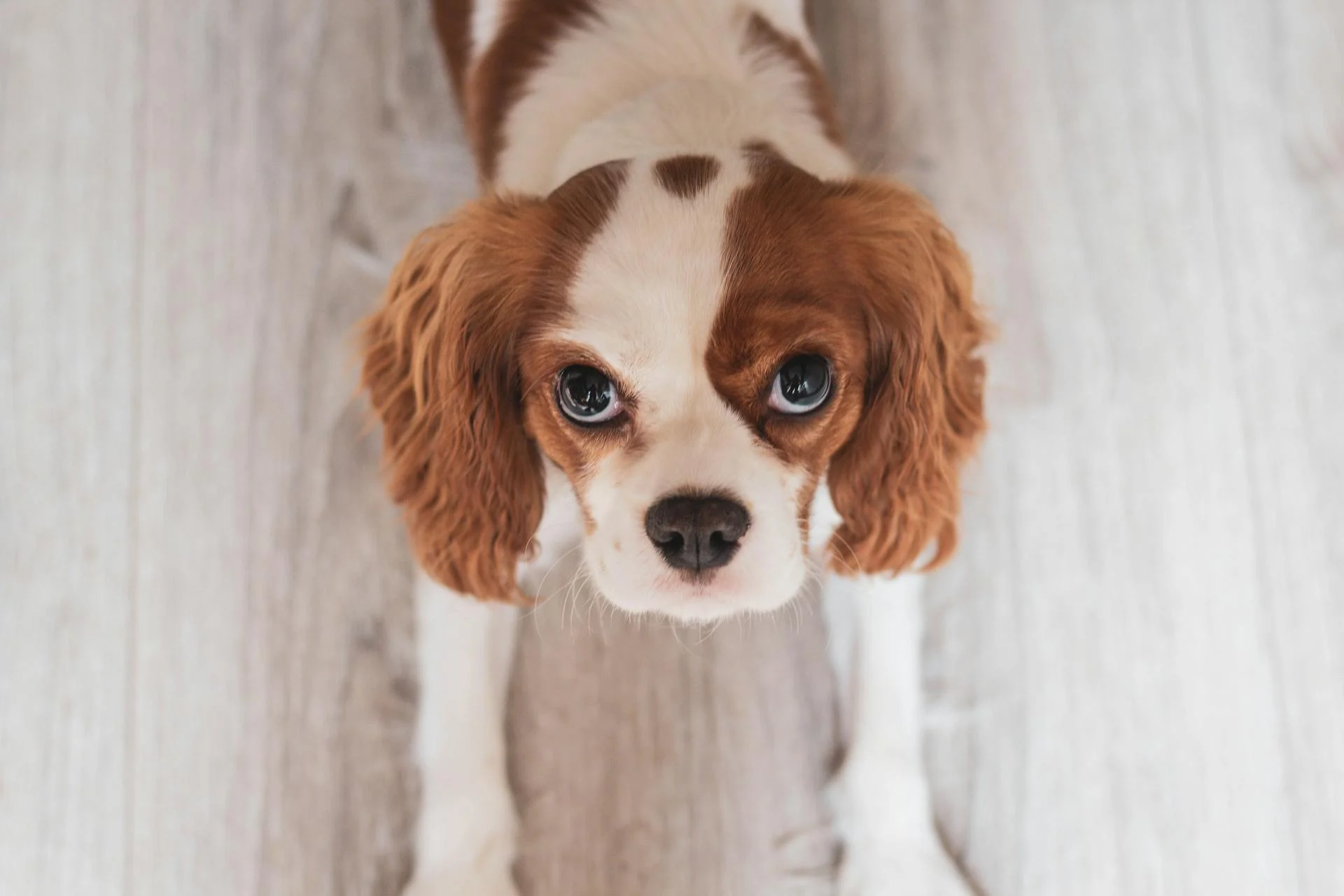
The Tibetan Terrier is a low-shedding breed that requires regular grooming to prevent matting and tangling. Their thick, double coat needs to be brushed daily to prevent knots.
Tibetan Terriers have a unique coat type that sheds very little, making them a great choice for people with allergies. However, this also means that their hair can become easily matted and tangled if not properly cared for.
To keep your Tibetan Terrier's coat healthy and looking its best, you'll need to invest in a good quality brush and learn how to properly groom them.
You might enjoy: Husky Blowing Coat before and after
Grooming Essentials
Daily brushing is a must for Tibetan Terriers, as their hair can mat and fuse together at the roots if not combed regularly.
Using a fine tooth metal comb, brush your dog's hair from root to tip daily, or at least three times a week if matting is a concern.
A brush alone will not keep mats away, especially if using the wrong type of brush.
Most harnesses, clothing, and outdoor activities can cause matting if your dog's hair is not dealt with daily.
Grooming every 4-6 weeks will not prevent matting, only daily home coat care will keep your Tibetan's hair unmatted.
For more insights, see: Pin Brush Dog Grooming
Grooming Tools
Invest in high-quality grooming tools such as slicker brushes and detangling combs to effectively manage their coats. Regular trimming of the hair around their paws and ears is important to keep them clean and free from debris.
Slicker brushes are particularly useful for removing tangles and mats from their coats. A detangling comb is essential for gently working out knots, especially in long-haired breeds.
Regular baths, ideally once a month, help keep their skin and coat healthy. This frequency helps maintain their natural oils and prevents skin irritations.
Building a Bond Through Grooming
Grooming sessions are a fantastic opportunity to bond with your Tibetan Terrier. These dogs enjoy human interaction and will come to associate grooming with positive experiences, strengthening your relationship with them.
Tibetan Terriers require daily grooming to prevent matting, which can be a haven for fleas, fungus, ticks, and hotspots.
Fine tooth metal combs are essential for keeping your Tibetan's hair unmatted, and using them daily from root to tip is crucial.
Using a brush alone will not keep mats away, especially if you're using the wrong type of brush.
Daily grooming is necessary to prevent matting, even if your dog doesn't seem to be matting quickly.
Grooming a Tibetian Terrier
Grooming a Tibetan Terrier is a daily habit that requires attention to detail and the right tools. You'll need to invest in high-quality grooming tools like slicker brushes and detangling combs to effectively manage their coats.
Regular trimming of the hair around their paws and ears is essential to keep them clean and free from debris. A monthly bath helps keep their skin and coat healthy.
Tibetan Terriers have a high-maintenance coat that needs to be combed daily from root to tip. This will prevent mats and tangles from forming. Fine tooth metal combs are the best tool for this job.
Using a brush alone will not keep mats away, especially if you're using the wrong type of brush. Most harnesses, clothing, and outdoor activities can cause matting if the hair is not dealt with daily.
Here are some popular grooming styles for Tibetan Terriers:
Grooming every 4-6 weeks will not avoid matting; only daily home coat care will prevent this.
Styling and Cuts
Tibetan Terriers have a thick, double coat that requires regular grooming to prevent matting. A Tibetan Terrier's fur can easily become matted if not properly cared for.
There are several popular haircut styles for Tibetan Terriers, including the Puppy Cut, Teddy Bear Cut, and 3-Layer Cut. The Puppy Cut is a popular choice for many owners.
The Puppy Cut involves clipping the dog's fur short, about 1.5-2 inches all over, to reduce the occurrence of matted fur. Some owners choose to leave the hair on the face, head, ears, and tail a bit longer.
The Teddy Bear Cut is similar to the Puppy Cut, but a little longer, with the body hair cut fairly short (2-3 inches), but the hair on the face, legs, and tail are left longer.
Here are some popular Tibetan Terrier haircut styles:
- Puppy Cut: clipped short (about 1.5-2 inches) all over
- Teddy Bear Cut: body hair cut fairly short (2-3 inches), with longer hair on face, legs, and tail
- 3-Layer Cut: hair on face and ears cut to about shoulder length, body hair cut to about 3 inches from the ground, and leg hair cut to just above the ground
It's best to consult a professional groomer for the 3-Layer Cut, as it requires more expertise.
Scissor Style
The scissor style trim is a great choice for breeds that want to retain their natural character while keeping their coat manageable.
This trim involves clipping the body down to a fairly short length, which makes it perfect for breeds that tend to mat or shed heavily.
The furnishings down the legs and belly are then scissored to the desired length, giving the dog a neat and tidy appearance.
To maintain the scissor style trim, you'll need to brush your dog between studio visits, which is usually recommended every 6 weeks, depending on the breed type and coat condition.
Regular brushing will help prevent matting and tangling, and keep your dog looking and feeling their best.
Curious to learn more? Check out: Hair Length Dog Grooming Blade Chart
Tibetan Terrier Styling
The Tibetan Terrier's fur is prone to matting, so it's common for owners to choose short haircut styles like the Puppy Cut or Teddy Bear Cut to reduce matting.
Many owners choose to give their Tibetan Terrier a short haircut style like the Puppy Cut or Teddy Bear Cut to reduce matting.
Consider reading: Teddy Bear Dog Grooming
A Puppy Cut involves clipping the Tibetan Terrier's fur short (about 1.5-2 inches) all over, with some owners choosing to leave the hair on the face, head, ears, and tail a bit longer.
The Teddy Bear Cut is similar to the Puppy Cut but a little longer, with the body hair cut fairly short (2-3 inches) and the hair on the face, legs, and tail left longer and carefully sculpted and rounded.
The 3-Layer Cut, also called the "3-Stack", involves cutting the hair on the face and ears to about shoulder length, the body hair to about 3 inches from the ground, and the leg hair to just above the ground.
Here are some popular short haircut styles for Tibetan Terriers:
Regular grooming is essential to prevent matting, and daily brushing with a fine-tooth metal comb is recommended to prevent mats from forming.
Frequently Asked Questions
Do Tibetan Terriers shed hair?
No, Tibetan Terriers do not shed their coat. However, they still need regular grooming to maintain their coat's health and appearance.
Should I shave my Tibetan Terrier?
Shaving your Tibetan Terrier can maintain cleanliness and fitness, but it may alter its breed appearance. Consider a compromise look by keeping some hair for a more authentic breed type appearance.
Does a Tibetan Terrier have a double coat?
Yes, the Tibetan Terrier has a double coat, consisting of a wooly undercoat and a long, fine topcoat. This unique coat requires regular grooming to prevent matting and tangling.
Sources
- https://www.trisongtibetans.com/post/caring-for-your-tibetan-terrier-grooming-tips-and-tricks
- https://www.dog-learn.com/dog-breeds/tibetan-terrier/grooming
- https://coatkinggroomers.com/dog-grooming-styles/
- https://www.atomic-canine.com/news/2010/12/truth-for-grooming-for-a-tibetian-terrier/
- https://www.pets4homes.co.uk/pet-advice/how-to-keep-a-tibetan-terriers-coat-looking-good.html
Featured Images: pexels.com


